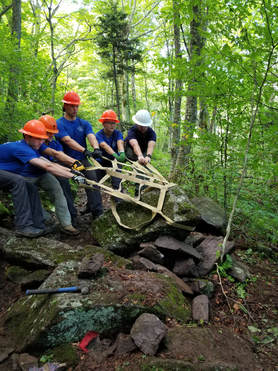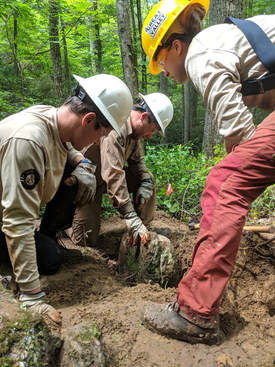Winter 2018 Newsletter
On a beautiful Saturday in June, a great group of Wilderness-loving folks gathered at the Dickerman farm in Swoope for the Virginia Wilderness Committee's Annual Meeting. Executive Director Mark Miller updated the group on our work regarding several current campaigns, including Lower Cowpasture, North Shenandoah Mountain, and the issue of Sustainable Recreation. Board Member Lynn Cameron shared updates on all of her work as co-chair of the Friends of Shenandoah Mountain. You’ll find information about all of these projects--plus more--in this newsletter.
With our annual election of new Officers and Board members at the meeting, VWC welcomed both new faces and old friends. The Board is now led by John Hutchinson, who stepped up from the Vice President position. Steve Johnson, who has been on the Board for several years, was voted in as the new Vice President. Larry Evans will remain as the Treasurer, and Pete Bsumek, VWC’s long-serving former Secretary, was coerced back into the position. Our two new Board members, who are also both new to VWC, are Tom Engle and Tyler Meader. Tom lives in Augusta County and is a recent retiree from the U.S. State Department after a 31-year career as a Foreign Service officer. Tom has been an avid hiker since spending his high school years near the Smoky Mountains, and his introduction to this region was through camping in the 1980’s in Ramsey’s Draft Wilderness. Tyler began his love of the outdoors when his family moved from the suburbs outside Harrisburg, Pennsylvania, to a historic home surrounded by woods, creeks, and the James River when he was 10. The Boy Scouts further acquainted him with the wonderful opportunities for hiking and camping that Virginia has to offer. Tyler lives in Glen Allen and works for the Virginia Department of Conservation and Recreation-Division of Natural Heritage (more complete biographies of all VWC Board members and advisors are available on our website at www.vawilderness.org.)
We look forward to another year of working on our priorities with these wonderful colleagues. The next year will be an exciting one for the Virginia Wilderness Committee!
With our annual election of new Officers and Board members at the meeting, VWC welcomed both new faces and old friends. The Board is now led by John Hutchinson, who stepped up from the Vice President position. Steve Johnson, who has been on the Board for several years, was voted in as the new Vice President. Larry Evans will remain as the Treasurer, and Pete Bsumek, VWC’s long-serving former Secretary, was coerced back into the position. Our two new Board members, who are also both new to VWC, are Tom Engle and Tyler Meader. Tom lives in Augusta County and is a recent retiree from the U.S. State Department after a 31-year career as a Foreign Service officer. Tom has been an avid hiker since spending his high school years near the Smoky Mountains, and his introduction to this region was through camping in the 1980’s in Ramsey’s Draft Wilderness. Tyler began his love of the outdoors when his family moved from the suburbs outside Harrisburg, Pennsylvania, to a historic home surrounded by woods, creeks, and the James River when he was 10. The Boy Scouts further acquainted him with the wonderful opportunities for hiking and camping that Virginia has to offer. Tyler lives in Glen Allen and works for the Virginia Department of Conservation and Recreation-Division of Natural Heritage (more complete biographies of all VWC Board members and advisors are available on our website at www.vawilderness.org.)
We look forward to another year of working on our priorities with these wonderful colleagues. The next year will be an exciting one for the Virginia Wilderness Committee!
Update on Wilderness legislation for the Lower Cowpasture project
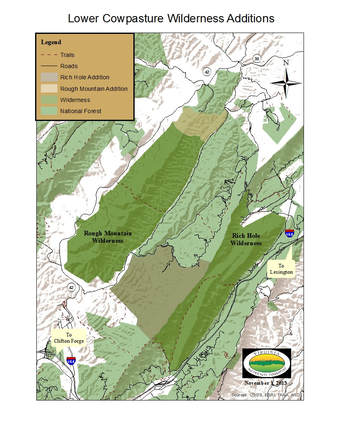
The Virginia Wilderness Additions Act of 2017 was introduced by Tim Kaine in October 2017. The bill was quickly passed out of committee and sent to the full Senate, without objection, for consideration. The bill was then included in a small Senate lands package that included additional Wilderness in Tennessee. This was a time for celebration!!
For those who work on Wilderness legislation in Virginia, it was a rare feat, accomplished due to long-standing relationship we have built with non-traditional allies, including the timber industry, game managers, and hunting organizations. This support was built through a Stakeholder Collaborative process and the collaborative’s support for the Lower Cowpasture Restoration and Management Project. The Virginia Wilderness Additions Act would increase the size of the Rich Hole Wilderness by over 4,600 acres, bringing the total acreage for the Rich Hole Wilderness to just over 11,000 acres. It would increase the size of the Rough Mountain Wilderness by just over 1,000 acres, bringing the total acreage to just over 10,000 acres. On their southern tips, these two Wildernesses are separated by a road and a railroad corridor; their nearly contiguous nature would create a Wilderness block of just over 21,000 acres.
The Additions Act was more recently included in the Senate version of the Farm Bill. However, the House version excluded the Virginia Wilderness additions. Due to this difference, and many other competing issues, the Farm Bill was sent to a Conference Committee, for the purpose of resolving the competing differences between the two bills before passage. Our hopes were high that the Virginia Additions Bill would be included in the final bill.
Sadly, politics have precluded any potential success. House committee members on the Conference Committee have refused to allow consideration for the Virginia Wilderness Additions to be included in the final version of the Farm Bill. It now appears that these two additions, which have the strong support of the Forest Service, local government, the timber industry, game managers, and hunting and recreation groups, will not make it into the Farm Bill.
While it is disappointing that the additions did not move in this Congress, the Rich Hole and Rough Mountain Wildernesses will continue to be a priority for VWC. We will again be working with Senator Kaine to ensure that the Wilderness Additions will quickly be brought up for consideration in the next Congress, and we will make every effort to ensure that the Rich Hole and Rough Mountain additions will be included in the National Wilderness Preservation System.
For those who work on Wilderness legislation in Virginia, it was a rare feat, accomplished due to long-standing relationship we have built with non-traditional allies, including the timber industry, game managers, and hunting organizations. This support was built through a Stakeholder Collaborative process and the collaborative’s support for the Lower Cowpasture Restoration and Management Project. The Virginia Wilderness Additions Act would increase the size of the Rich Hole Wilderness by over 4,600 acres, bringing the total acreage for the Rich Hole Wilderness to just over 11,000 acres. It would increase the size of the Rough Mountain Wilderness by just over 1,000 acres, bringing the total acreage to just over 10,000 acres. On their southern tips, these two Wildernesses are separated by a road and a railroad corridor; their nearly contiguous nature would create a Wilderness block of just over 21,000 acres.
The Additions Act was more recently included in the Senate version of the Farm Bill. However, the House version excluded the Virginia Wilderness additions. Due to this difference, and many other competing issues, the Farm Bill was sent to a Conference Committee, for the purpose of resolving the competing differences between the two bills before passage. Our hopes were high that the Virginia Additions Bill would be included in the final bill.
Sadly, politics have precluded any potential success. House committee members on the Conference Committee have refused to allow consideration for the Virginia Wilderness Additions to be included in the final version of the Farm Bill. It now appears that these two additions, which have the strong support of the Forest Service, local government, the timber industry, game managers, and hunting and recreation groups, will not make it into the Farm Bill.
While it is disappointing that the additions did not move in this Congress, the Rich Hole and Rough Mountain Wildernesses will continue to be a priority for VWC. We will again be working with Senator Kaine to ensure that the Wilderness Additions will quickly be brought up for consideration in the next Congress, and we will make every effort to ensure that the Rich Hole and Rough Mountain additions will be included in the National Wilderness Preservation System.
Shenandoah Mountain Support Keeps Growing
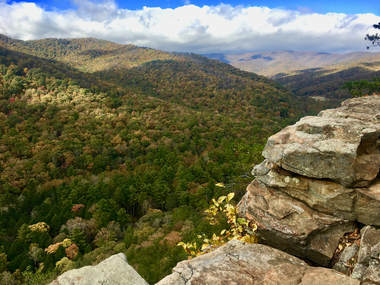 Cliff Trail at Hone Quarry, looking toward Shenandoah Mountain. Photo by Christy Bradburn, VWC Board member
Cliff Trail at Hone Quarry, looking toward Shenandoah Mountain. Photo by Christy Bradburn, VWC Board member
Friends of Shenandoah Mountain (FOSM) has made substantial progress in building support for the 90,000-acre proposed Shenandoah Mountain National Scenic Area and embedded Wilderness. We now have 356 endorsements from a wide range of organizations and businesses! Tourism-related businesses like restaurants, breweries, wineries, coffee shops, and bakeries see our proposal as an opportunity to enhance economic development by protecting natural beauty and recreational resources. Massanutten Trout Unlimited endorsed the proposal to protect some of Virginia’s healthiest native trout streams.
As part of our efforts, we have reached out to neighboring landowners, many of whom think a National Scenic Area (NSA) would make a good neighbor and enhance their property values. We have presented to organizations ranging from Daughters of the American Revolution to Ruritans, and we have offered naturalist-led outings on mushrooms, lichens, geology, butterflies, and wildflowers. Additionally, with help from faithful supporters, FOSM has exhibited at music festivals and other gatherings.
FOSM has facilitated the involvement of university students. James Madison University and Eastern Mennonite University students continue to help by taking photos, making story maps, writing articles, soliciting endorsements, and clearing trails. The students benefit from the experiences, and so does the campaign.
This year, we have sponsored a series of well-attended programs on the history of Shenandoah Mountain. On November 19th, FOSM and the Augusta County Historical Society offered a program on the Flood of 1949, when torrential rains on Shenandoah Mountain caused historic flooding of the North River. For more information on this and other events, please sign up for our mailing list at friendsofshenandoahmountain.org.
In order to continue this exciting progress, GWNF Stakeholders need the Forest Service to initiate a landscape level project around the periphery of the proposal to facilitate planning of management activities to enhance habitat for game and other species. The Forest Service lacks the capacity to initiate a project at this time, but FOSM will continue building support until the time is right for legislation to be introduced. We’ll continue to keep our VWC members updated. Overall, FOSM has made many new friends.
As part of our efforts, we have reached out to neighboring landowners, many of whom think a National Scenic Area (NSA) would make a good neighbor and enhance their property values. We have presented to organizations ranging from Daughters of the American Revolution to Ruritans, and we have offered naturalist-led outings on mushrooms, lichens, geology, butterflies, and wildflowers. Additionally, with help from faithful supporters, FOSM has exhibited at music festivals and other gatherings.
FOSM has facilitated the involvement of university students. James Madison University and Eastern Mennonite University students continue to help by taking photos, making story maps, writing articles, soliciting endorsements, and clearing trails. The students benefit from the experiences, and so does the campaign.
This year, we have sponsored a series of well-attended programs on the history of Shenandoah Mountain. On November 19th, FOSM and the Augusta County Historical Society offered a program on the Flood of 1949, when torrential rains on Shenandoah Mountain caused historic flooding of the North River. For more information on this and other events, please sign up for our mailing list at friendsofshenandoahmountain.org.
In order to continue this exciting progress, GWNF Stakeholders need the Forest Service to initiate a landscape level project around the periphery of the proposal to facilitate planning of management activities to enhance habitat for game and other species. The Forest Service lacks the capacity to initiate a project at this time, but FOSM will continue building support until the time is right for legislation to be introduced. We’ll continue to keep our VWC members updated. Overall, FOSM has made many new friends.
The Great Dismal Swamp National Wildlife Refuge
On a recent trip to the southeastern corner of Virginia, VWC’s Executive Director Mark Miller began to explore possible Wilderness candidates for The Great Dismal Swamp National Wildlife Refuge. The refuge was established in 1974 to help protect and preserve a portion of the Great Dismal Swamp, a marshy region on the Coastal Plain of southeastern Virginia and northeastern North Carolina between Norfolk, Virginia, and Elizabeth City, North Carolina. The refuge currently encompasses over 112,000 acres of swamp, although, originally, it covered much of southeastern Virginia and northeastern North Carolina. It is both an environmentally and biologically significant area. Special designations for the refuge include both the Virginia and Globally Important Bird Area designations, a National Parks Services National Natural Landmark, and the Underground Railroad Network to Freedom site designations.
In 2006, a Comprehensive Conservation Plan (CCP) was completed for the refuge. The plan considered six areas for Wilderness; five of these were in Virginia, and one was in North Carolina. Unfortunately, all of them were rejected either for need of significant management to improve hydrological functions or due to previous human disturbances. VWC met with the Refuge Manager earlier this year to discuss Wilderness and the lack of Wilderness recommendations in the CCP. We learned that the refuge is developing a new Habitat Management Plan and requested that Wilderness be considered as part of a mosaic of habitats for inclusion in the plan. At the time, there were no decisions made on possible Wilderness candidates or legislation; however, the manager did not object to our having discussions with Congressman McEachin’s staff or Senator Kaine’s staff about possible future Wilderness designation for the swamp.
VWC has reached out to the Friends of the Dismal Swamp about Wilderness for the swamp, as well as the Chesapeake Chapter of the Sierra Club. We will continue our discussion with these groups in December and into 2019 about support for Wilderness in the swamp.
In 2006, a Comprehensive Conservation Plan (CCP) was completed for the refuge. The plan considered six areas for Wilderness; five of these were in Virginia, and one was in North Carolina. Unfortunately, all of them were rejected either for need of significant management to improve hydrological functions or due to previous human disturbances. VWC met with the Refuge Manager earlier this year to discuss Wilderness and the lack of Wilderness recommendations in the CCP. We learned that the refuge is developing a new Habitat Management Plan and requested that Wilderness be considered as part of a mosaic of habitats for inclusion in the plan. At the time, there were no decisions made on possible Wilderness candidates or legislation; however, the manager did not object to our having discussions with Congressman McEachin’s staff or Senator Kaine’s staff about possible future Wilderness designation for the swamp.
VWC has reached out to the Friends of the Dismal Swamp about Wilderness for the swamp, as well as the Chesapeake Chapter of the Sierra Club. We will continue our discussion with these groups in December and into 2019 about support for Wilderness in the swamp.
Funding Needed to Protect our Public Lands: America’s National Treasures
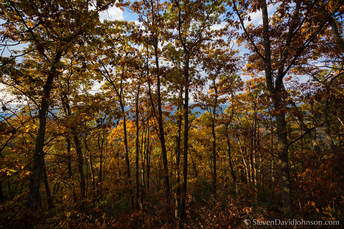
America was the first country to take its most scenic and natural places and turn them into a shared space belonging to all. These public lands are the cherished wild places that restore our spirits and provide solitude. In the U.S., most of our public lands are held by the federal government and are managed by the Bureau of Land Management, the U.S. National Park Service, or the Fish and Wildlife Service under the Department of the Interior, or the U.S. Forest Service under the Department of Agriculture. Federal public lands are held in trust for all Americans by these land management agencies, with the goal of land management both for the long-term health of the land and American citizens. Every American is an equal owner of our public lands, which provide thousands of jobs and billions of dollars in economic returns. Unfortunately, our land management agencies are being starved of the necessary funding needed to sustain and protect these vital shared spaces.
Public lands are places where Americans from all walks of life can go for exercise, stimulation and adventure, and to connect with nature. More than 57 million people live within 25 miles of federal public lands. In the commonwealth, these public lands, including their trails, campsites, cabins, and boat launches, help generate $21.9 billion in annual revenue on outdoor recreation activities. They also keep our air and water clean and protect the amazing biodiversity found in the Southern Appalachians.
The National Park Service (NPS) manages 84 million acres of public land for the enjoyment, education, and inspiration of all Americans. For each $1 invested in the NPS, the American public receives $4 in economic value. In 2011, national parks generated $30.1 billion in economic activity and 252,000 jobs nationwide. The U.S. Forest Service manages 154 national forests under a multiple use concept, meaning they provide a number of services, including recreation, water, timber, grazing, minerals, wildlife, and others. These forests total 193,000,000 acres (8.5% of the country). In Virginia, the George Washington and Jefferson National Forests encompass nearly 1.8 million acres, creating one of the largest blocks of public land in the eastern United States.
Although there is strong public support and abundant economic incentive for land protection and recreational use of our parks and forests, our elected leaders are depriving our land management agencies of the funding needed to safeguard and maintain public lands. Recently, our elected leaders did not vote to extend the nation’s most important source of conservation funding--the Land and Water Conservation Fund (LWCF). The LWCF has invested more than $344 million to protect Virginia’s open spaces, historic sites and battlefields, and increase recreation access.
The Virginia Wilderness Committee supports increased funding for our land management agencies, as well as LWCF. The resiliency of our public lands is dependent upon us treating them with respect and giving them the care they need, which cannot be accomplished without proper funding.
Please tell your congressional delegation to support funding for land management agencies and the Land and Water Conservation Fund! Find your Representatives and Senators through these links:
Senators
Representatives
Public lands are places where Americans from all walks of life can go for exercise, stimulation and adventure, and to connect with nature. More than 57 million people live within 25 miles of federal public lands. In the commonwealth, these public lands, including their trails, campsites, cabins, and boat launches, help generate $21.9 billion in annual revenue on outdoor recreation activities. They also keep our air and water clean and protect the amazing biodiversity found in the Southern Appalachians.
The National Park Service (NPS) manages 84 million acres of public land for the enjoyment, education, and inspiration of all Americans. For each $1 invested in the NPS, the American public receives $4 in economic value. In 2011, national parks generated $30.1 billion in economic activity and 252,000 jobs nationwide. The U.S. Forest Service manages 154 national forests under a multiple use concept, meaning they provide a number of services, including recreation, water, timber, grazing, minerals, wildlife, and others. These forests total 193,000,000 acres (8.5% of the country). In Virginia, the George Washington and Jefferson National Forests encompass nearly 1.8 million acres, creating one of the largest blocks of public land in the eastern United States.
Although there is strong public support and abundant economic incentive for land protection and recreational use of our parks and forests, our elected leaders are depriving our land management agencies of the funding needed to safeguard and maintain public lands. Recently, our elected leaders did not vote to extend the nation’s most important source of conservation funding--the Land and Water Conservation Fund (LWCF). The LWCF has invested more than $344 million to protect Virginia’s open spaces, historic sites and battlefields, and increase recreation access.
The Virginia Wilderness Committee supports increased funding for our land management agencies, as well as LWCF. The resiliency of our public lands is dependent upon us treating them with respect and giving them the care they need, which cannot be accomplished without proper funding.
Please tell your congressional delegation to support funding for land management agencies and the Land and Water Conservation Fund! Find your Representatives and Senators through these links:
Senators
Representatives
A Word from a VWC Friend
By Zach Foster, founder and Program Director of the Great Appalachian Valley Conservation Corps (GAVCC) and VWC Board Advisor
Freshly repaired trail in over-loved Wilderness areas has a way of jumping out to me when I’m weary from a day of high-stepping through washed out tread or wading through bog holes on an old logging road. It’s not that the repair itself stands out- good tread work should blend into the land; it is the sense that the path I’m walking is solid, well thought out, and is built to resist erosion and hard use.
But, more often than not, the crews that built these trails have moved on by the time most hikers notice the work. For that reason, many folks never see the people keeping our trails in good shape.
Two regional programs- The Southern Appalachian Wilderness Stewards (SAWS) and the Great Appalachian Valley Conservation Corps (GAVCC), have stepped in to partner with the Forest Service’s mission to preserve Wilderness character where designated and maintain recreational access on our public lands. Furthermore, both groups bring a focus on creating opportunities for young people to serve on public lands, build technical and leadership skills, and develop a stronger connection to the land.
The Southern Appalachian Wilderness Stewards supported work on the George Washington and Jefferson National Forest with both Wilderness Field Crews and Wilderness Rangers and Specialists. These crews and individuals repaired trails, educated the public, and collected data across twelve Wilderness Areas and two areas with Wilderness characteristics. In total, SAWS participants contributed 8,343 hours of service on the George Washington and Jefferson National Forest.
The Great Appalachian Valley Conservation Corps spent the 2018 field season improving recreational access and protecting habitat in Wilderness managed areas in the George Washington and Jefferson National Forest, the Monongahela National Forest, and Shenandoah National Park. The GAVCC sent eleven youth and young adult crews into the field this year- including two crews that used their skillsets to support hurricane recovery efforts in Puerto Rico and Florida.
Locally, GAVCC crews focused on building re-routed trail sections to avoid flood damaged areas and cleared blow down in difficult to reach areas. The GAVCC crews also had the opportunity to meet with National Park Service (NPS) and US Forest Service (USFS) staff to learn about educational and career paths with land management agencies. By partnering with the USFS and NPS, the GAVCC helped themcomplete backlogged maintenance, while creating new opportunities for young adults interested in public lands conservation.
Strong agency and non-profit partnerships and the drive to build a culture of Wilderness awareness and respect are critical to making sure that Virginia’s Wilderness Areas remain protected and appreciated. Don’t hesitate to slow down and say hello to the next group of young folks you see in hard hats on the trail- they are the next generation of public land stewards!
Freshly repaired trail in over-loved Wilderness areas has a way of jumping out to me when I’m weary from a day of high-stepping through washed out tread or wading through bog holes on an old logging road. It’s not that the repair itself stands out- good tread work should blend into the land; it is the sense that the path I’m walking is solid, well thought out, and is built to resist erosion and hard use.
But, more often than not, the crews that built these trails have moved on by the time most hikers notice the work. For that reason, many folks never see the people keeping our trails in good shape.
Two regional programs- The Southern Appalachian Wilderness Stewards (SAWS) and the Great Appalachian Valley Conservation Corps (GAVCC), have stepped in to partner with the Forest Service’s mission to preserve Wilderness character where designated and maintain recreational access on our public lands. Furthermore, both groups bring a focus on creating opportunities for young people to serve on public lands, build technical and leadership skills, and develop a stronger connection to the land.
The Southern Appalachian Wilderness Stewards supported work on the George Washington and Jefferson National Forest with both Wilderness Field Crews and Wilderness Rangers and Specialists. These crews and individuals repaired trails, educated the public, and collected data across twelve Wilderness Areas and two areas with Wilderness characteristics. In total, SAWS participants contributed 8,343 hours of service on the George Washington and Jefferson National Forest.
The Great Appalachian Valley Conservation Corps spent the 2018 field season improving recreational access and protecting habitat in Wilderness managed areas in the George Washington and Jefferson National Forest, the Monongahela National Forest, and Shenandoah National Park. The GAVCC sent eleven youth and young adult crews into the field this year- including two crews that used their skillsets to support hurricane recovery efforts in Puerto Rico and Florida.
Locally, GAVCC crews focused on building re-routed trail sections to avoid flood damaged areas and cleared blow down in difficult to reach areas. The GAVCC crews also had the opportunity to meet with National Park Service (NPS) and US Forest Service (USFS) staff to learn about educational and career paths with land management agencies. By partnering with the USFS and NPS, the GAVCC helped themcomplete backlogged maintenance, while creating new opportunities for young adults interested in public lands conservation.
Strong agency and non-profit partnerships and the drive to build a culture of Wilderness awareness and respect are critical to making sure that Virginia’s Wilderness Areas remain protected and appreciated. Don’t hesitate to slow down and say hello to the next group of young folks you see in hard hats on the trail- they are the next generation of public land stewards!
In Memoriam
It is with great sadness that we share the news of the passing of Robert “Bob” Dickerman. Bob was a great friend to Wilderness and a life-long supporter of the Virginia Wilderness Committee. He graciously welcomed us to use his family farm in Buffalo Gap for our Annual Meetings each year. He will be sorely missed.
Fine Trails of Rockbridge, by Mark Miller, VWC Executive Director
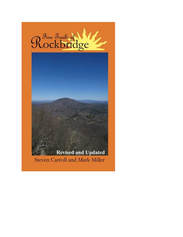
Just in time for holiday gift giving, the updated version of the Fine Trails of Rockbridge, a hiking guide to Rockbridge County, is available on Amazon and some bookstores in Lexington. All proceeds from the book will be donated to VWC and the Rockbridge Area Conservation Council (RACC).
Now is the time to support the permanent protection of our public lands.
2018 was a big year for VWC but we need YOUR help for 2019!
We are so grateful for your continued support of the Virginia Wilderness Committee. Your generous contributions enable us to protect and promote Virginia’s most special wild areas, and more specifically recently, by supporting the introduction of Wilderness legislation for south eastern Bath county. With your help, the Virginia Wilderness Committee hopes to accomplish the following goals in 2019:
FIRST, we hope to see legislation reintroduced by Senator Tim Kaine in 2019, designating additions to the Rich Hole and Rough Mountain Wilderness Areas (5,600 acres in all) and will need to travel to DC numerous times to discuss legislation with our representatives.
SECOND, VWC would like to continue the discussions of adding Wilderness designations to part of the Great Dismal Swamp, introducing permanently protected public land to the eastern side of Virginia.
THIRD, we will also keep our momentum on the Shenandoah Mountain campaign by continuing to build public support for the proposed National Scenic Area and embedded Wilderness.
FOURTH, expand the number of educational presentations on Wilderness, reaching more audiences across Virginia. Please contact us at [email protected] to invite VWC to speak to your group.
Thank you for recognizing and valuing the work of the Virginia Wilderness Committee!
We could not do it without your support!
FIRST, we hope to see legislation reintroduced by Senator Tim Kaine in 2019, designating additions to the Rich Hole and Rough Mountain Wilderness Areas (5,600 acres in all) and will need to travel to DC numerous times to discuss legislation with our representatives.
SECOND, VWC would like to continue the discussions of adding Wilderness designations to part of the Great Dismal Swamp, introducing permanently protected public land to the eastern side of Virginia.
THIRD, we will also keep our momentum on the Shenandoah Mountain campaign by continuing to build public support for the proposed National Scenic Area and embedded Wilderness.
FOURTH, expand the number of educational presentations on Wilderness, reaching more audiences across Virginia. Please contact us at [email protected] to invite VWC to speak to your group.
Thank you for recognizing and valuing the work of the Virginia Wilderness Committee!
We could not do it without your support!

